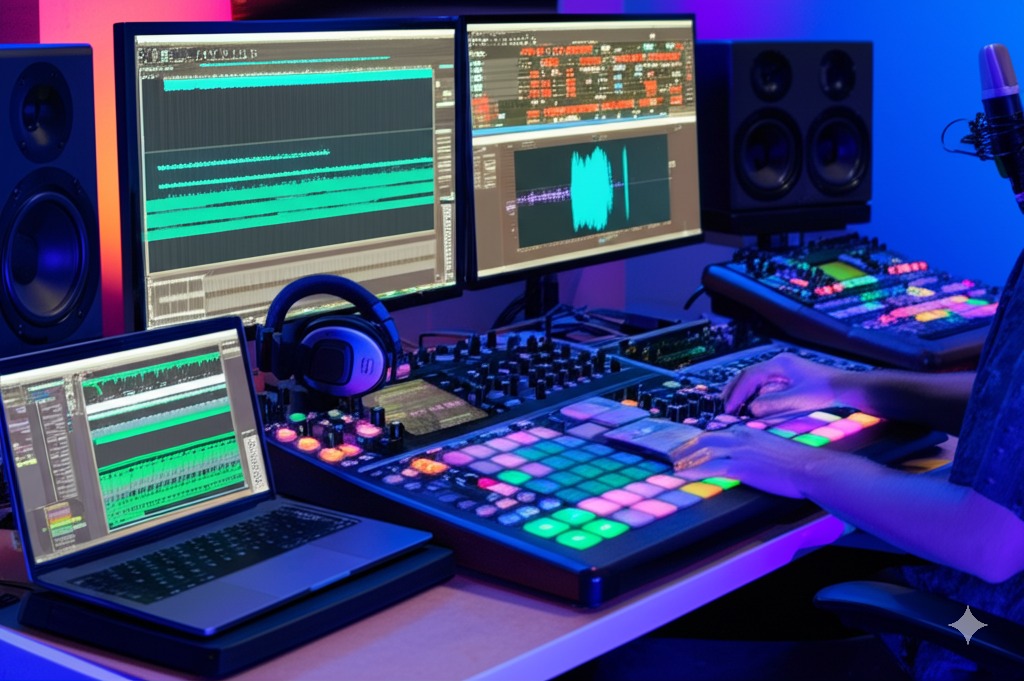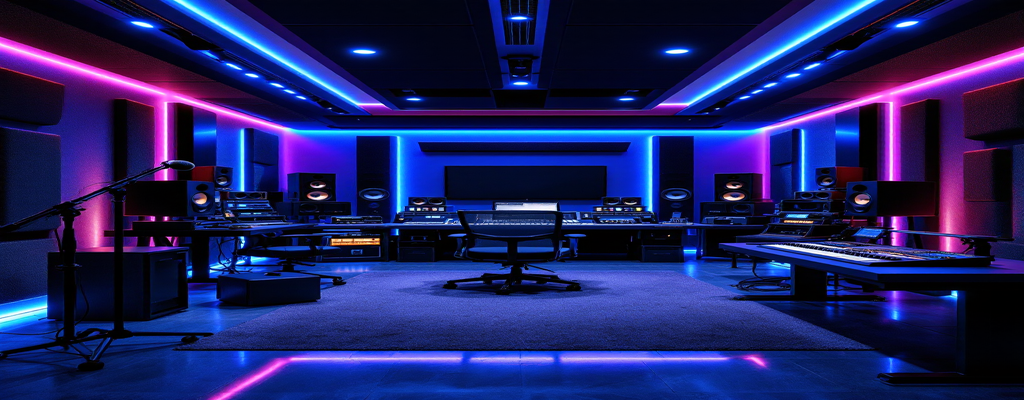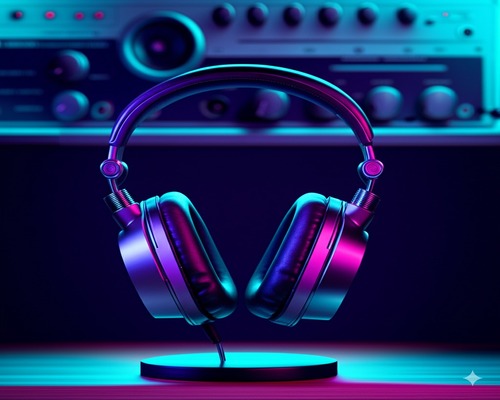What Is AI Music Production?
AI music production is making music with the help of smart computer programs. These AI tools can write melodies, create beats, add harmony, make fake vocals, and even polish your final track—often doing a lot of the work for you.
Introduction
Making music has completely changed in the last few years. We now have AI tools that can do everything from creating simple drum loops to writing entire songs from scratch. This means making music is faster, easier to get into, and lets you try wild new ideas that might have been too hard before.
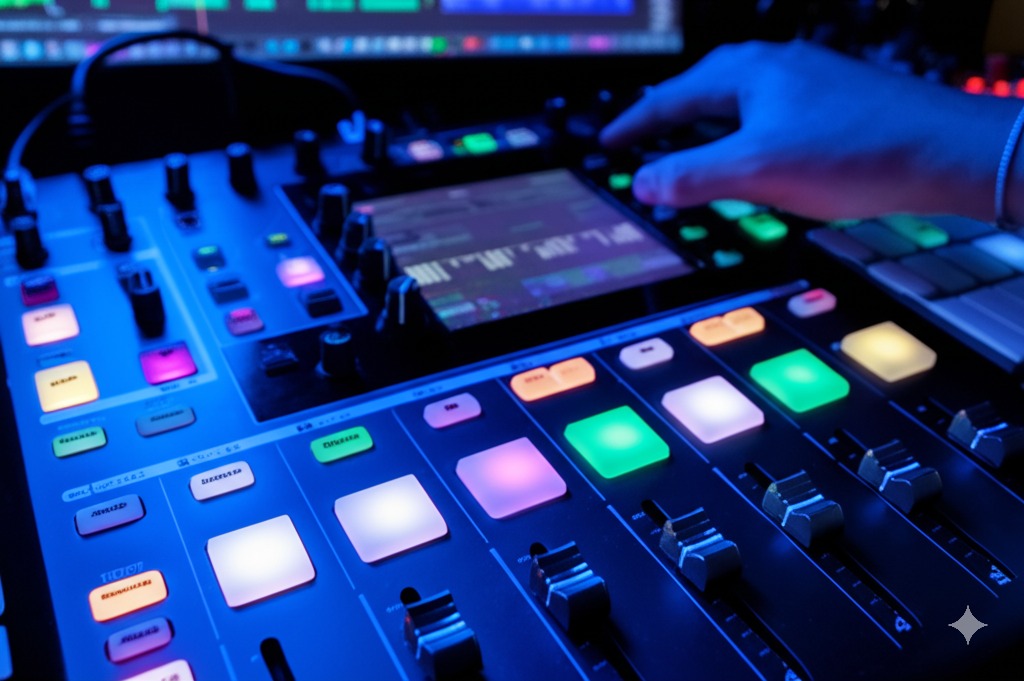
AI Music Production: Revolutionizing the Creative Process
AI music production involves using computer intelligence to help create musical content. Let’s look at how this technology has grown and why it matters to musicians today.
The evolution of AI in music
The journey of AI music production started with simple computer programs that could make basic tunes. Over time, these systems got smarter, learning to understand musical patterns and styles. Today’s AI music production tools use advanced neural networks that can analyze thousands of songs and create new music that sounds like it was made by humans.
Core technologies powering AI music
Behind the scenes, AI music production relies on several key technologies:
- Recurrent Neural Networks (RNNs): These help AI understand how music flows over time
- Generative Adversarial Networks (GANs): These create new musical ideas by having two AI systems compete against each other
- Transformer models: These help AI understand the bigger picture of how music is structured
Each of these technologies, as explained by LALAL.AI, plays a unique role in how AI music production works.
Benefits for creators
Using AI music production tools gives musicians several advantages:
- Time-saving: AI can generate ideas quickly when you’re stuck
- Creative inspiration: AI suggests musical ideas you might not have thought of
- Accessibility: People without formal music training can now create impressive tracks
Integration with traditional production
AI music production works best alongside human creativity, not replacing it. Many producers use AI to handle repetitive tasks or generate starting ideas, then add their personal touch to make the music unique and emotional.
AI Music Producer: Skills, Tools, and Career Opportunities
The role of an AI music producer combines technical know-how with creative vision. Let’s explore what it takes to work in this exciting field.
Essential skills for modern AI music producers
Becoming an AI music producer requires a mix of musical knowledge and technical skills:
- Basic understanding of music theory (chords, scales, rhythm)
- Familiarity with traditional recording concepts
- Comfort with digital technology and music software
- Ability to direct and shape AI outputs into finished songs
You don’t need to be a coding expert, but knowing how to communicate what you want to the AI is key for successful AI music production.
Top AI production software in 2025
Several platforms lead the AI music production space:
- AIVA – Creates compositions for film, games, and commercials
- Soundraw – Offers genre-specific music generation
- Amper Music – Provides easy-to-use templates for quick creation
- Magenta Studio – Lets musicians experiment with Google’s music AI

Each of these AI music studio tools offers unique features for different needs and skill levels, as highlighted by Elegant Themes.
Career pathways in AI music production
Working as an AI music producer opens up several career opportunities:
- Creating music for films, ads, and video games
- Developing new AI music production tools
- Teaching others how to use AI for music creation
- Working with traditional musicians to enhance their sound
As AI music production continues to grow, so do the job prospects in this innovative field.
Financial considerations
Making money as an AI music producer involves understanding:
- Subscription models for AI music studio tools
- Licensing options for music you create
- Ways to monetize your work through streaming, sync licensing, and sales
- Copyright considerations for AI-generated content
AI Music Studio: Setting Up Your Digital Environment
Creating your own AI music studio doesn’t have to be complicated or expensive. Here’s what you need to get started.
Essential hardware for AI music creation
Your AI music studio needs these basic components:
- A decent computer (laptop or desktop)
- Audio interface for connecting instruments and microphones
- Headphones or speakers for listening to your creations
- MIDI controller (optional but helpful)
The computing power needed depends on whether you’re processing music locally or using cloud-based AI music production tools.
Software ecosystem
The heart of your AI music studio is the software that powers it:
- Digital Audio Workstations (DAWs) like Ableton Live, Logic Pro, or FL Studio
- Standalone AI generators like AIVA or Amper Music
- AI plugin options that add AI functions to your existing software
Many beginners start with simpler tools and gradually build up their AI music production capabilities.
Cloud-based vs. local processing
When setting up your AI music studio, you’ll need to choose between:
- Cloud-based tools: Run on remote servers, require internet connection, but need less powerful computers
- Local processing: Happens on your computer, works offline, but needs more computing power
According to experts at On-Page AI, cloud-based options often provide the best balance of power and accessibility for beginners.
Budget-friendly studio setups
You can create a basic AI music studio without breaking the bank:
- Start with free or low-cost AI music generators
- Use budget audio interfaces ($100-200 range)
- Begin with computer speakers before investing in studio monitors
- Utilize free DAW options like GarageBand or Cakewalk
Remember that many professional-quality tracks today are created in home AI music studios with minimal equipment.
AI Music Recording: Capturing and Processing AI-Generated Content
Once you’ve set up your AI music studio, it’s time to understand how AI music recording works.
Input methods for AI systems
You can communicate with AI music production tools in several ways:
- Text prompts: Describe the music you want (“upbeat jazz with piano”)
- MIDI input: Play melodies or chords the AI can build upon
- Audio reference: Upload songs with styles you want to emulate
Different AI music recording tools accept different types of input, so check what works best for your chosen software.
Real-time vs. rendered recording
AI music recording typically happens in one of two ways:
- Real-time generation: The AI creates music as you play or interact with it
- Rendered creation: You set parameters and the AI generates a complete piece
Real-time is great for jamming and experimentation, while rendered works better for polished, final productions in your AI music recording studio.
Post-processing AI-generated audio
After the initial AI music recording, your track will likely need some refinement:
- Adjusting volumes between different elements
- Adding effects like reverb or delay
- Correcting timing or pitch issues
- Arranging sections into a complete song structure
This is where your human touch makes the AI music production truly unique.
Stem separation and manipulation
Modern AI music recording studio workflows often involve working with stems (individual parts of a song):
- Isolate vocals, drums, bass, or other elements from complete mixes
- Process each stem separately for better control
- Recombine elements with appropriate balance
Tools like LALAL.AI specialize in this kind of separation, making it easier to work with and modify existing recordings.
AI Music Recording Studio: Professional Setups for Maximum Quality
Creating a professional AI music recording studio goes beyond basic setups. Let’s explore how to build a space that maximizes the quality of your AI music production.
Studio design considerations for AI music
Your AI music recording studio environment affects the final sound:
- Acoustic treatment: Add bass traps, diffusers, and absorption panels to control reflections
- Monitoring setup: Position speakers properly and create a symmetrical listening space
- Workflow optimization: Arrange your equipment for comfortable, efficient sessions
A well-designed AI music studio makes it easier to hear exactly what your AI is creating without room coloration affecting your decisions.
Advanced equipment for AI audio capture
Professional AI music recording studio setups typically include:
- High-quality audio converters for clean signal paths
- Accurate studio monitors for truthful sound representation
- Control surfaces that make interacting with AI music production software more intuitive
While these upgrades aren’t necessary when starting out, they become important as you advance in your AI music production journey.
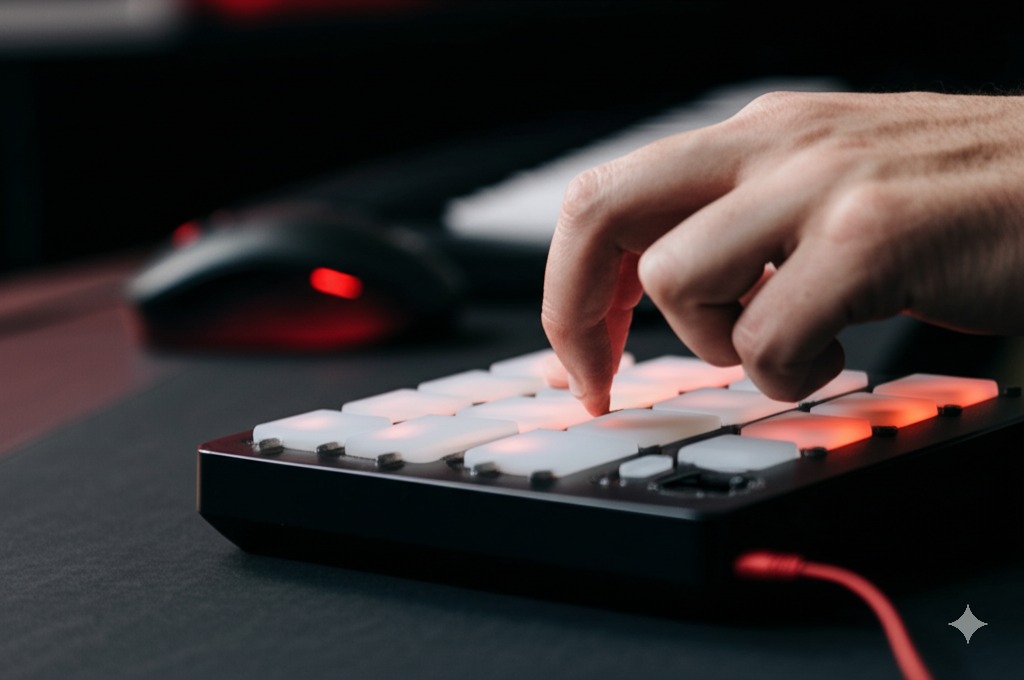
Hybrid setups
Many professional AI music producers combine AI tools with traditional instruments:
- Record live instruments alongside AI-generated elements
- Use AI to complement human performances
- Process real recordings through AI enhancers
This approach, recommended by IBM’s Watson Beat experts, creates a unique sound that blends organic feel with AI music production innovation.
Collaborative AI studio environments
Modern AI music recording studio setups often support team collaboration:
- Cloud-based project sharing
- Version control for collaborative editing
- Remote session capabilities
These tools make it possible for multiple AI music producers to work together even when physically apart.
SEO Optimization for AI Musicians
Creating great music with AI music production is only half the battle—you also need people to find and hear it. Here’s how to optimize your AI-created music for discovery.
Platform-specific optimization
Each streaming service has unique requirements for AI music production metadata:
- Spotify: Focus on playlist placement and accurate genre tags
- Apple Music: Emphasize album artwork and complete song information
- YouTube: Create descriptive titles and tags that include AI music production keywords
As In Classics explains, tailoring your approach to each platform increases your chances of being discovered.
AI-assisted keyword research for musicians
Use AI tools to find trending terms related to your AI music production:
- Research popular search terms in your genre
- Identify hashtags that music fans are using
- Discover niche communities interested in AI music recording
This research helps you position your music where potential listeners are already looking.
Content strategy for AI musicians
Beyond the music itself, create supporting content about your AI music studio process:
- Behind-the-scenes videos of your AI music production workflow
- Blog posts explaining your approach to AI music recording
- Tutorials showing how you use AI tools
According to Jack Righteous, this content strategy helps build authority and drives organic traffic to your music.
Building backlinks in the music industry
Grow your online presence through strategic connections:
- Collaborate with other AI music producers
- Get featured on music production blogs
- Join online communities focused on AI music studio setups
These relationships help increase your visibility and credibility in the AI music production space.

AI Music Technologies: Understanding the Core Systems
Understanding how AI music production technologies work helps you get the most from these tools. Let’s break down the key systems.
Recurrent Neural Networks (RNNs)
RNNs are essential for sequential music generation:
- They remember previous notes to create coherent melodies
- They understand how musical patterns develop over time
- They can learn specific musical styles or genres
These networks form the foundation of many AI music production tools.
Generative Adversarial Networks (GANs)
GANs use a creative tension to generate new music:
- One part (generator) creates musical content
- Another part (discriminator) judges if it sounds authentic
- This back-and-forth produces increasingly realistic AI music recording outputs
This technology is behind some of the most impressive AI music studio innovations.
Transformer models
Transformer technology has revolutionized AI music production:
- Attention mechanisms help AI understand musical context
- Models can grasp long-term structure in compositions
- They produce more coherent and musically satisfying results
These advanced models power the latest generation of AI music recording studio software.
Music Information Retrieval (MIR)
MIR systems analyze and categorize music:
- Extract features like tempo, key, and instrumentation
- Identify similarities between different pieces
- Help AI understand what makes specific genres unique
These analytical tools help train better AI music production systems and organize musical content.
Ethical and Legal Considerations in AI Music Production
The rise of AI music production raises important questions about ownership, rights, and ethical use.
Copyright implications
When using AI music recording tools, consider:
- Who owns music created with AI assistance?
- What rights do AI developers have to music made with their tools?
- How current copyright law applies to AI music production
These questions remain actively debated in the music industry and legal circles.
Sampling and derivative works
AI music producers should understand:
- Legal frameworks around sampling existing music
- Best practices for using copyrighted material
- How to properly credit sources and influences
Following established guidelines helps avoid legal issues with your AI music production.
Transparency in AI usage
Being open about your AI music studio process is increasingly important:
- Consider disclosing when AI tools were used in creation
- Explain your role in directing and editing AI outputs
- Be honest with listeners about how your music was made
This transparency builds trust with your audience while the norms around AI music recording continue to evolve.
Cultural appropriation concerns
AI music production raises ethical questions about style and influence:
- Consider the implications of using AI to emulate specific cultural styles
- Respect the origins of musical traditions you’re working with
- Think about how to acknowledge influences appropriately
Approaching these issues thoughtfully helps ensure your AI music production respects the diverse traditions that inspire it.
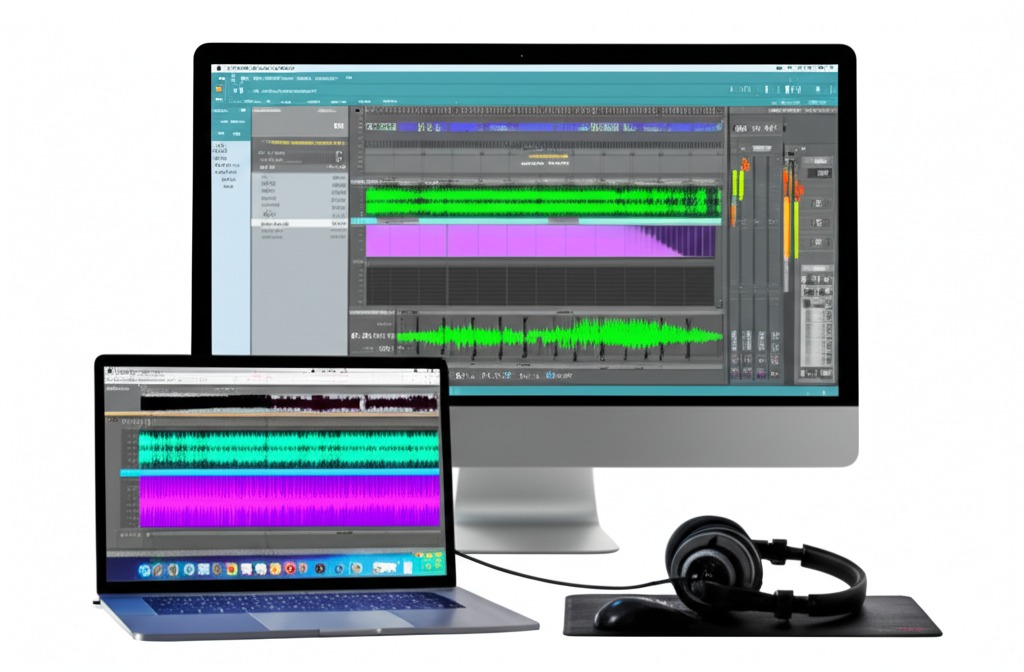
Use Cases: Real-World Applications of AI Music Production
AI music production tools are being used in many different contexts. Here are some practical examples.
Commercial Music Production
Businesses are embracing AI music studio technology:
- Endel creates functional music for focus and sleep using AI music production
- AIVA composes music for film scoring with AI assistance
These commercial applications show how AI music recording is becoming mainstream in professional contexts.
Music Education
AI music production tools are transforming how we learn and teach music:
- Magenta Studio helps students understand composition principles through AI music generation
- Amper Music supports music theory instruction with computational creativity
These educational applications of algorithmic composition make music learning more accessible and engaging for students at all levels.
Live Performance Enhancement
AI music technology is finding its way onto stages:
- IBM’s Watson Beat collaborates with artists during live performances
- Holly+ uses voice modeling for innovative performances
These applications show how generative music systems can enhance live shows and create new performance possibilities.
Sound Design and Foley
AI music software helps create and manipulate sounds for various media:
- LALAL.AI offers stem separation for synthetic audio production
- Sounds.com provides AI-generated sound effect libraries
Sound designers use these music machine learning tools to create everything from realistic environmental sounds to otherworldly effects.
For essential resources, dive into AI Tools for Musicians and see how AI is transforming the soundscape in Impact of AI in Music.
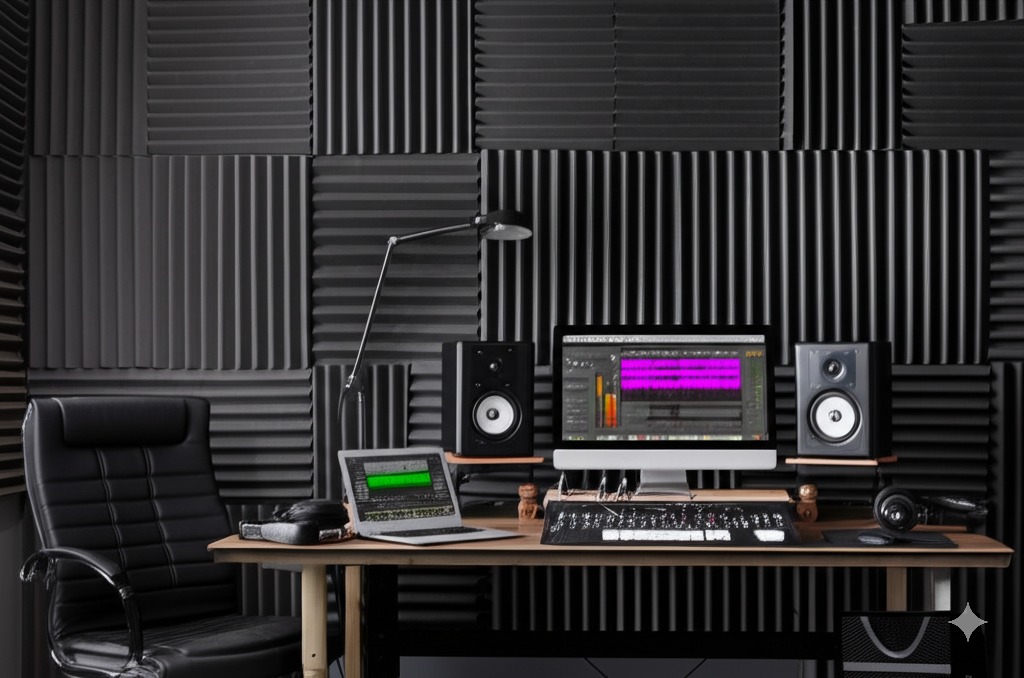
Future Trends in AI Music Production
The field of AI music production continues to evolve rapidly. Here are some emerging trends to watch.
Multi-modal generation
Future AI music composition tools will combine different creative modes:
- Systems that generate music based on images or video
- Tools that create synchronized visual and audio content
- AI music technology that responds to movement or dance
This integration will create more immersive and cohesive multi-sensory experiences.
Emotional intelligence in AI composition
Neural networks for music are becoming more emotionally aware:
- AI systems that understand and evoke specific feelings
- Tools that can generate music matching particular emotional states
- AI music software that adapts to listener responses
This emotional intelligence will help create more moving and effective musical experiences.
Decentralized collaboration
Blockchain and Web3 technologies are changing AI music production workflows:
- Shared ownership of AI music generation projects
- Transparent credit and compensation systems
- New models for fan participation in the creative process
These developments are reshaping how musicians collaborate and share their work.
Accessibility advancements
AI music technology is making production more inclusive:
- Tools designed for musicians with disabilities
- Interfaces that adapt to different user abilities
- Algorithmic composition systems that work with alternative inputs
These advances help ensure that AI music production is available to everyone who wants to create.
Getting Started: Step-by-Step Guide to Your First AI Music Production Project
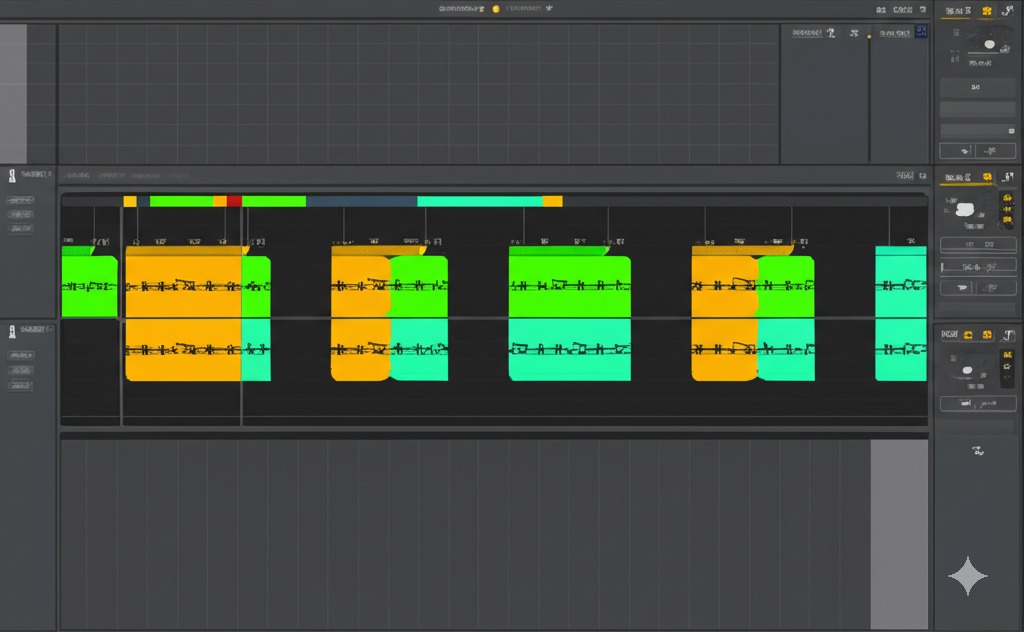
Ready to try AI music production yourself? Here’s how to begin your journey.
Choosing the right AI music tool for beginners
For those wondering about the best AI tools for independent musicians, consider:
- User-friendly interfaces with minimal learning curve
- Free or low-cost options to experiment with
- Tools that match your musical style and goals
The right AI music software depends on your specific needs and experience level.
Creating your first AI composition
Follow these steps for how to create professional music with AI:
- Start with a clear idea of what you want to create
- Use text prompts or musical seeds to guide the AI
- Generate multiple options and select the best
- Edit and refine the AI output to make it your own
This process helps you maintain creative control while leveraging AI music generation capabilities.
Common pitfalls and how to avoid them
When learning AI music production for beginners, watch out for:
- Over-reliance on AI without adding your personal touch
- Using default settings instead of exploring options
- Not organizing or backing up your projects
- Expecting perfect results without iteration
Understanding these challenges helps make your AI music production journey smoother.
Building on AI outputs
Transform basic AI music composition into finished tracks by:
- Adding your own instrumental or vocal performances
- Applying thoughtful mixing and mastering
- Arranging AI-generated segments into complete songs
- Using AI music technology as a starting point rather than the final product
This approach creates unique music that combines AI assistance with human creativity.
Setting up an AI music studio on a budget
You don’t need expensive equipment to start with AI music production:
- Use free or trial versions of AI music software
- Leverage cloud-based options to reduce hardware requirements
- Start with the computer and headphones you already have
- Gradually add equipment as your skills and needs grow
With smart planning, you can create an effective AI music studio without breaking the bank.
How to optimize AI-generated music for streaming platforms
To maximize reach for your AI music production, focus on:
- Creating complete, accurate metadata for all platforms
- Designing eye-catching artwork that stands out
- Building playlists that include your AI-generated tracks
- Engaging with listener communities interested in computational creativity
These strategies help your music find the right audience across streaming services.
Discover more in our dedicated sections: AI Music Technology & Innovation for insights into the future of sound, and AI Music Creation Tools for hands-on guidance with the latest tools.
Conclusion: Embracing the AI Music Production Revolution
The world of music machine learning and AI music technology continues to evolve at an incredible pace. Whether you’re a seasoned producer or complete beginner, AI music production tools offer exciting new ways to create, collaborate, and share music.
The most successful AI music producers understand that these technologies work best as creative partners rather than replacements for human creativity. By combining your unique musical vision with the capabilities of AI music generation, you can create something truly original.
As we’ve seen in this guide, starting with AI music production doesn’t require expensive equipment or technical expertise. With a basic AI music studio setup and an understanding of key concepts, you can begin making high-quality music right away.
The future of algorithmic composition and synthetic audio production looks brighter than ever. As these technologies continue to develop, they’ll open up even more possibilities for musical expression and innovation.
So what are you waiting for? Dive into the world of AI music production and discover how these powerful tools can help bring your musical ideas to life!

Frequently Asked Questions
1. Can AI-generated music be copyrighted?
Yes, AI music production outputs can generally be copyrighted, but it’s complicated. The copyright typically belongs to the person who directed the AI and made creative choices about the final composition. However, laws vary by country, and some places require human authorship for copyright protection. It’s best to check the terms of service for any AI music software you use and consult legal advice for commercial projects.
2. What is the best free AI music generation tool for beginners?
For beginners looking to try AI music production without spending money, Soundraw and AIVA both offer free tiers that provide good starting points. OpenAI’s MuseNet is also free to use for basic algorithmic composition. These tools are user-friendly and don’t require technical knowledge, making them perfect for those just starting their journey into music machine learning.
3. How do streaming platforms classify AI-generated music?
Most streaming platforms don’t have specific categories for AI music production, so these tracks are classified like any other music based on genre, mood, and instrumentation. However, some platforms may require disclosure if substantial portions were created using AI music technology. The categorization affects how your music is discovered, so use appropriate genre tags and metadata when uploading music created with computational creativity tools.
4. Do I need programming knowledge to use AI music production tools?
No, most modern AI music software is designed with user-friendly interfaces that don’t require programming skills. While some advanced tools might benefit from technical knowledge, the majority of AI music generation applications work through simple controls, text prompts, or music theory concepts. This accessibility is why AI music production for beginners has grown so popular—you can create professional-sounding tracks without coding experience.
5. Can AI music tools replicate specific artists’ styles?
Yes, many neural networks for music can analyze and mimic the stylistic elements of specific artists or genres. However, this raises ethical and legal questions about originality and copyright. The best practice is to use these capabilities for inspiration rather than exact replication, allowing the AI music composition to guide you toward creating your own unique sound that may be influenced by, but not copying, existing artists.
6. How much computational power do I need for AI music production?
The computational requirements depend on the specific AI music production tools you’re using. Many cloud-based services handle the heavy processing on their servers, so you only need a decent internet connection. For local AI music studio setups running advanced software, a modern computer with at least 8GB RAM and a good CPU is recommended. Graphics cards (GPUs) can accelerate some AI music technology but aren’t always necessary for beginners learning how to create professional music with AI.
7. Are there any genre limitations in current AI music technologies?
While AI music software has improved dramatically, some genres are better represented than others. Mainstream pop, rock, classical, and electronic music typically work well with current AI music generation tools. More niche or experimental genres, complex jazz, or music from specific cultural traditions might be more challenging for AI to accurately capture. However, this limitation is constantly shrinking as music machine learning models continue to improve and diversify.
8. How can I make my AI-generated music sound more human?
To make AI music production sound more natural and less robotic:
- Add performance variations in velocity, timing, and dynamics
- Introduce subtle imperfections that human players would naturally create
- Incorporate real instrumental or vocal recordings alongside the AI elements
- Use algorithmic composition for structure but add personal touches to expression
These techniques help bridge the gap between synthetic audio production and the organic quality of human performance.
